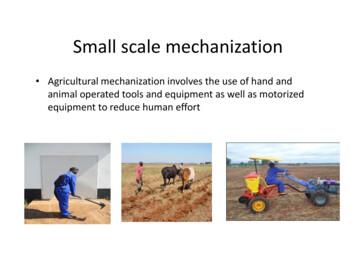Small Scale Mechanization - FACASI
Small scale mechanization Agricultural mechanization involves the use of hand andanimal operated tools and equipment as well as motorizedequipment to reduce human effort
Agric mechanization improves the1) Timeliness of operations and2) Quality of the various operationsThe above two increases- yields- quality of product- overall efficiency of crop production.
Small scale mechanisation therefore involvesthe use of the above mentioned tools andequipment but with low capacities Tools and equipment that can be used bysmall scale farmers are relatively cheaper andeasy to operate and maintain
Small scale mechanized equipment (like 2WT) will thereforefill in the gap between the commonly used animal draftpowered equipment and standard commercial equipment like4 WT
ADVANTAGES OF 2 WHEEL TRACTORS BASED ON CA Low procurement cost Low operational costs ( 15-20/ha labour, fuel, maintenanceoverheads) Tractor can be used for various uses planting, transport,shelling etc Planters used with the 2WT can plant various crops (maizesugar beans, sunflower, finger millet, sorghum, cow pea) Planters can be set to plant various plant populations, andfertilzers.
Good germination rates Equipment portable, can be transported with a 1 tonne pickup truck. The 2WT with a single row planter can be used to drill basalfertilizer after germination The 2WT can also be to drill urea fertilzer (Urea is a cheaperoption comppared to AN The combination of 2WT and planter produces straight linewhich facilitate post germination use of other equipment
Conservation Agriculture Mechanization CA mechanization refers to selection, utilizationand management of agricultural machinery andequipment under CA practices governed by CAprinciples. Any equipment or machinery to be used under CAmust ensure minimum soil disturbance, leave cropresidue covering the soil, plant all crops used inCA rotation.
CA Machinery selection Principles of CA machinery selectioninvolves the process of making a decisionon what type of machinery or implementto use under CA. The selection of CA machinery is based ontechnical and financial issues.
TECHNICAL ISSUES1. Implement/machine capacities Small areas of less than one ha, the recommendedmechanization system are manual based systemsnamely basins and jab planters. These implements have very low capacities.
The direct seeders and rippers arerecommended for areas of up to three ha and forlarger areas tractor drawn direct seeders arerecommended. These are of high capacities.
Technical issues cont.2. Source of draught powerIn situations where farmers have no access todraught power, basins and jab planters arerecommended.Where animal draught power is available, theripper tines and direct seeders arerecommended.
Technical issues cont.3. Labour RequirementsManual based systems are labour intensive ascompared to mechanized systems.
FINANCIAL ISSUES Capital is required to invest in CA machinery. Under these circumstances, hiring and groupownership is recommended. Repair and maintenance costs are reduced inthis arrangement.
Operational costs are high with directseeders as opposed to shaka hoes andrippers. Farmers with limited resources aretherefore recommended to use shaka hoesand rippers which are less sophisticated.
CHALLENGES WITH MACHINERYEnd users require skills to set, operate, calibrateand maintain the equipment for it to serve theintended purpose.
BENEFITSThe introduction machinery in CA has thefollowing advantages it reduces drudgery counter act labour shortages a catalyst in CA upsacaling
Thank You.
Jan 25, 2016 · easy to operate and maintain Small scale mechanized equipment (like 2WT) will therefore . Planters used with the 2WT can plant various crops (maize sugar beans, sunflower, finger millet, sorghum, cow pea) . namely basins and jab planters.
MECHANIZATION AND TECHNOLOGY Overview Farm mechanization is an important element of modernization of agriculture. Farm . Tamil Nadu and West Bengal during 1965 to 1970. Many of the State Governments have increased their equity participation as a result of which the Government of India, at present, is a minority shareholder. .File Size: 791KB
CCC-466/SCALE 3 in 1985 CCC-725/SCALE 5 in 2004 CCC-545/SCALE 4.0 in 1990 CCC-732/SCALE 5.1 in 2006 SCALE 4.1 in 1992 CCC-750/SCALE 6.0 in 2009 SCALE 4.2 in 1994 CCC-785/SCALE 6.1 in 2011 SCALE 4.3 in 1995 CCC-834/SCALE 6.2 in 2016 The SCALE team is thankful for 40 years of sustaining support from NRC
Svstem Amounts of AaCl Treated Location Scale ratio Lab Scale B en&-Scale 28.64 grams 860 grams B-241 B-161 1 30 Pilot-Plant 12500 grams MWMF 435 Table 2 indicates that scale up ratios 30 from lab-scale to bench scale and 14.5 from bench scale to MWMW pilot scale. A successful operation of the bench scale unit would provide important design .
Serving farm, outdoor power, farmstead mechanization and industrial dealers JAN 2020 FAST FACT MSEDA: Committed to building the best business environment for equipment dealers. . term business plan to take a larger share of the global tractor and farm machinery markets. 2020.
System Block Diagram and Mechanization and Mechanization Data Acquisition System FCW Processor (Data Fusion & Threat Assessment) Vision System Haptic Actuator CAN Bus Speaker Sensor & I/O Processor Driver-Vehicle Interface Unit Scene Tracking Processor Target Path-Estimation & Selection Processor ACC/Radar Subsystem ACC Controller Radar Camera
to track the changes at a glance, the following pages use different font typefaces to identify the changes. Bold type (no underlining) New CIP code. . 01.02 Agricultural Mechanization 01.0201 Agricultural Mechanization, General . 01.0204 Agricultural Power Machinery Operator .
LIVESTOCK MECHANIZATION: AN OPTION BETTER THAN GRAZING LAND FOR CATTLE REARING IN NIGERIA *1Ale, M. O, 1Akintade, A. A., and 2Asolo, O. H 1Department of Agricultural and Bio-Environmental Engineering Technology 2Deparment of Animal Health and Production Technology Rufus Giwa Polytechnic, Owo, Ondo State, Nigeria
Nazism and the Rise of Hitler 49 In the spring of 1945, a little eleven-year-old German boy called Helmuth was lying in bed when he overheard his parents discussing something in serious tones. His father, a prominent physician, deliberated with his wife whether the time had come to kill the entire family, or if he should commit suicide alone. His father spoke about his fear of revenge, saying .























